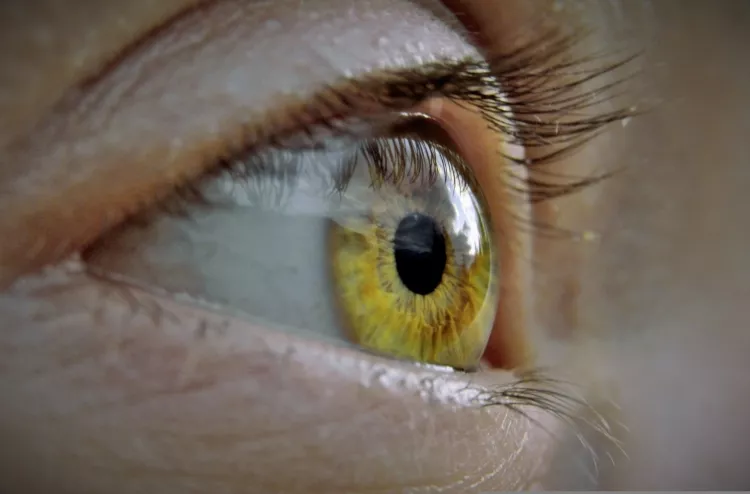As we age, our bodies undergo various changes, and our eyes are no exception. One of the most common age-related eye conditions is cataracts, and it is important to be vigilant for cataract symptoms. Cataracts occur when the natural lens of the eye becomes cloudy, causing blurred vision and impacting daily activities. The good news is that it is relatively simple to get cataracts surgically removed to restore clear vision and improve overall quality of life.
So, what are the first signs of cataracts? Here, we’ll discuss some common cataract symptoms that may indicate the need for cataract surgery.
What Are the Common Symptoms of Cataracts?
Cataracts are a common eye condition that typically develops slowly over time, although the speed at which they progress can vary from person to person. While the exact symptoms experienced by individuals can differ, there are some associated with cataracts that are generally universal. Some early symptoms of cataracts may include:
Blurred Vision
One of the first common signs of cataracts is a gradual clouding or blurring of vision. This can make it difficult to see clearly, like looking through a foggy or frosted window.
The intensity and nature of blurred vision in cataract patients can vary depending on the individual and the stage of cataract development.
Cataracts primarily affect the clarity of vision by clouding the eye’s natural lens. This clouding occurs within the lens itself, which is located just behind the coloured part of the eye (the iris). As the cataract develops, it becomes progressively denser and more opaque. This opacification scatters and blocks the passage of light through the lens, resulting in blurred vision.
Early Stages: In the early stages of cataract development, the blurred vision may be relatively mild and may not significantly impact daily activities. Some people describe it as similar to looking through a smudged or dirty window. At this stage, patients may not be aware of the cataract, or they may mistake the visual changes for a normal part of ageing.
Intermediate Stages: As the cataract continues to develop, the clouding of the lens becomes more pronounced, leading to progressively blurred vision. It’s like looking through frosted or fogged-up glass. Colours may also appear dull or faded. This stage often prompts individuals to seek an eye examination because of a noticeable visual impairment.
Advanced Stages: In advanced cataract cases, the blurred vision can become quite severe, and the cloudiness in the lens may be extensive. At this point, reading, driving, or recognising faces can become extremely challenging. The lens may appear significantly opaque, resembling a cloudy or milky area within the eye when viewed by a healthcare professional using specialised equipment.
It’s important to note that cataracts can affect different parts of the lens, and the nature and location of the opacification can vary among individuals. This can lead to variations in how people experience blurred vision. Additionally, cataracts can develop in one or both eyes, and the degree of blurriness may differ between the eyes.
Signs of cataracts

Vision Loss
Advanced cataracts can cause significant vision impairment and a range of distressing symptoms. The extent of vision loss can vary from person to person, but in advanced cases, individuals may experience:
- Severe Blurred Vision: The blurred vision in advanced cataracts is often akin to looking through a dense fog or mist. Objects may appear hazy and indistinct, making it challenging to read, watch television, or perform routine tasks.
- Reduced Contrast Sensitivity: Cataracts can impair the ability to differentiate between shades of colour and contrast. Colours may appear washed out, and it can be difficult to discern subtle differences in texture or patterns.
- Glare and Halos: Bright lights, such as headlights from oncoming cars or street lamps, can cause intense glare and halos in the field of vision. This can be particularly problematic for night driving, making it uncomfortable and unsafe.
- Diplopia (Double Vision): Advanced cataracts may lead to diplopia, which is the perception of two distinct images of a single object. This can significantly impact depth perception and coordination.
- Loss of Visual Acuity: Visual acuity, or the ability to see fine details, deteriorates markedly with advanced cataracts. Reading small print or recognising faces at a distance becomes increasingly challenging.
- Impaired Night Vision: Night vision is notably affected. The combination of reduced contrast sensitivity, glare, and halos around lights can make navigating in low-light conditions, such as driving at night or walking in dimly lit areas, exceedingly difficult.
The timeline of potential vision loss due to cataracts is highly variable and depends on several factors, including the type of cataract, its location within the lens, and individual differences. Here’s a rough outline based on the stage of the cataract:
Early Stage: In the early stages, cataracts may develop gradually over several years, and vision changes can be subtle. Many individuals may not even realise they have cataracts at this point.
Intermediate Stage: As cataracts progress, typically over several months to a few years, vision impairment becomes more noticeable. This is often when people seek medical attention due to difficulties with daily activities.
Advanced Stage: Advanced cataracts lead to severe vision loss. This stage is characterised by significant discomfort and a reduced ability to perform everyday activities.
Frequently changing spectacle prescriptions are a sign of cataracts

Experiencing Fading Colours
As cataracts develop, they can lead to a noticeable change in the way individuals perceive colours. This occurs because the cloudy or opaque areas within the lens scatter and block light as it enters the eye. This scattering effect can lead to several colour-related symptoms:
- Colour Desaturation: Cataracts can cause colours to appear washed out and less vibrant or saturated. For example, vivid reds may appear more muted, and bright blues may seem duller.
- Yellowing or Browning: Some cataracts can lead to a yellow or brownish tint to vision, especially noticeable in bright or white light. This can affect how individuals perceive whites and other colours in their surroundings.
- Difficulty Distinguishing Colours: In advanced cataract cases, the ability to distinguish between different colours can be impaired. This can make it challenging to identify colour-coded objects or recognise subtle colour variations.
Driving with cataracts that cause fading colours can become problematic, especially as the condition progresses. The extent to which it affects driving depends on the severity of the cataracts and the specific circumstances.
Sensitivity to Light
Those with cataracts often experience heightened sensitivity to bright lights (photophobia). Glare from headlights while driving at night can be particularly bothersome and may indicate the need for surgery. This sensitivity to light occurs due to changes in the eye’s lens, and the cataract causes light to scatter when it enters the eye. The impact can vary in intensity depending on the stage and type of cataract.
Photophobia associated with cataracts can significantly impact a person’s quality of life and daily activities. It may affect their ability to:
- Drive safely, particularly when faced with oncoming headlights or glare from wet roads.
- Participate in outdoor activities on sunny days.
- Work in environments with bright overhead lighting or glare from computer screens.
- Read or perform tasks in well-lit areas where the contrast between light and dark is pronounced.
- Enjoy outdoor sports or activities without discomfort.
The most effective treatment for cataract-related photophobia is cataract surgery.
Difficulty with Night Vision
Difficulty with night vision is a common issue for people with cataracts. Cataracts cloud the eye’s lens, reducing light transmission and causing glare from oncoming headlights and streetlights. This glare can be blinding, making it challenging to see the road and surrounding objects. Additionally, cataracts impair contrast sensitivity, making it harder to distinguish objects in varying lighting conditions.
Driving at night with symptomatic cataracts is dangerous due to:
- Reduced Visibility: Cataracts limit the amount of light entering the eye, making it hard to see clearly in low-light conditions.
- Increased Glare: Glare from headlights and lights can be blinding, temporarily impairing vision.
- Slower Reaction Time: Reduced visibility and impaired night vision lead to slower reaction times, increasing the risk of accidents.
- Accident Risk: The combination of these factors elevates the risk of accidents, especially in nighttime driving.
So, is it possible to drive with cataracts? To ensure safety, individuals with symptomatic cataracts and night vision issues are advised to limit or avoid night driving until they undergo cataract surgery.
Additional Common Symptoms Include:
There are several additional symptoms that cataract sufferers may experience, including:
- Changes in prescription: cataracts cause the lens in your eye to change shape. You may find you have more changes to your spectacle prescription as cataracts progress.
- Frequent Headaches: Cataracts can contribute to frequent headaches, especially after engaging in visual tasks.
- Increased Eye Fatigue: This can manifest through strained vision; cataracts cause blurred and cloudy vision, making it necessary for individuals to exert extra effort to focus on objects. This constant straining of the eye muscles can lead to fatigue and discomfort. Unlike typical eye fatigue that often improves with rest, cataract-related eye fatigue can persist even after getting adequate rest, as the underlying cause, the cataract, continues to affect vision.
- Impaired Peripheral Vision: Cataracts can reduce peripheral vision, limiting the ability to see objects to the side. This can be particularly problematic when driving or navigating crowded spaces.
- Difficulty with Reading: Reading can become challenging due to blurred or cloudy vision caused by cataracts. Words may appear unclear or distorted, requiring more effort to read.
- Reduced Contrast Sensitivity: Cataracts diminish contrast sensitivity, making it harder to distinguish objects from their background, especially in varying lighting conditions.
- Poor Depth Perception: Impaired depth perception can result from cataracts, making it difficult to judge distances accurately. This can affect activities like driving and sports.
Experiencing Difficulties with Daily Activities
Quite often, cataracts can begin to interfere with your ability to perform daily activities, such as cooking, cleaning, or even hobbies you once enjoyed.
It’s important to note that the severity and progression of cataracts can vary among individuals, and not everyone may experience all of these symptoms. If you notice any changes in your vision or have concerns about the health of your eyes, it is always advisable to consult with an ophthalmologist or optometrist for a thorough evaluation.
Remember, early detection and prompt treatment through cataract surgery can help restore clear vision and improve your overall visual function, ultimately enhancing your quality of life.
Can Cataract Symptoms Come and Go?
Cataract symptoms typically do not come and go. They usually develop gradually and persist as the cataract progresses. Cataracts are characterised by the clouding or opacity of the eye’s natural lens, and this cloudiness is not a reversible condition. As the cataract becomes denser or larger, it causes more significant vision impairment. However, the experience of cataract symptoms may vary in different lighting conditions or depending on the specific visual tasks individuals are performing.
You’re in Safe Hands: Meet Our Cataract Surgeons
At Optegra, we are cataract surgery specialists. Our range of nationwide eye hospitals is equipped with the latest technology set within 5-star facilities to ensure your treatment is comfortable from start to finish. Our renowned cataract surgeons are NHS-trained and Fellows of the Royal College of Ophthalmologists (RCO). You are in the best possible hands!
We offer a range of treatments to help remove your cataracts. If you’re an NHS patient, you can request a referral to have your cataract treated at your local Optegra eye hospital. We also have enhanced and advanced cataract surgery treatment options for those who would like to reduce their reliance on glasses while having their cataract removed.
Contact us for more information on how we can help.

By Author: Amir Hamid
Mr. Amir Hamid is a Clinical Lead for Vision Correction and an expert refractive surgeon, based in London.
Medically Reviewed Date: 6th October 2023
